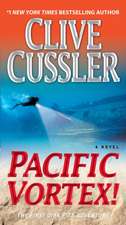Inca Gold
Autor Clive Cussleren Limba Engleză Paperback – 12 ian 2017
The twelfth hair-raising Dirk Pitt thriller sees the adventurer hunt for a fabulous hoard of Inca gold, before the richest prize known to man is lost forever.
| Toate formatele și edițiile | Preț | Express |
|---|---|---|
| Paperback (2) | 70.28 lei 3-5 săpt. | |
| Pocket Star Books – 30 sep 2007 | 70.28 lei 3-5 săpt. | |
| HarperCollins Publishers – 12 ian 2017 | 84.32 lei 3-5 săpt. | +18.11 lei 5-11 zile |
Preț: 84.32 lei
Nou
Puncte Express: 126
Preț estimativ în valută:
16.13€ • 16.89$ • 13.35£
16.13€ • 16.89$ • 13.35£
Carte disponibilă
Livrare economică 17-31 martie
Livrare express 01-07 martie pentru 28.10 lei
Preluare comenzi: 021 569.72.76
Specificații
ISBN-13: 9780008216641
ISBN-10: 0008216649
Pagini: 544
Dimensiuni: 131 x 199 x 35 mm
Greutate: 0.44 kg
Editura: HarperCollins Publishers
ISBN-10: 0008216649
Pagini: 544
Dimensiuni: 131 x 199 x 35 mm
Greutate: 0.44 kg
Editura: HarperCollins Publishers
Recenzii
United Press International "Cussler can keep anyone on the edge of their chair
with his gripping descriptions of action...."
Chicago Tribune "Cussler has developed and patented a vibrant,
rollicking narrative style that seldom shows signs
of relenting...."
Richmond Times-Dispatch "Cussler is a master at building suspense and
tension... high-tech adventure, a little romance
and a whale of a story...."
Tom Clancy "A new Clive Cussler novel
is like a visit from your best friend."
Atlanta Journal and Constitution "Lovers of undersea adventure...
should get to know DIRK PITT"
with his gripping descriptions of action...."
Chicago Tribune "Cussler has developed and patented a vibrant,
rollicking narrative style that seldom shows signs
of relenting...."
Richmond Times-Dispatch "Cussler is a master at building suspense and
tension... high-tech adventure, a little romance
and a whale of a story...."
Tom Clancy "A new Clive Cussler novel
is like a visit from your best friend."
Atlanta Journal and Constitution "Lovers of undersea adventure...
should get to know DIRK PITT"
Extras
1
From the bottom of the pool to the sun above, the water gradually lightened from a dismal gray-brown to a pea-soup green from the pond scum that flourished under the tropical heat. The circular rim stretched 30 meters (98 feet) across and the sheer walls dropped 15 meters (49 feet) to the water. Once in, there was no way a human or animal could escape without help from above.
There was an ugliness about the deep limestone sinkhole, or cenote as it was technically called, a repugnant menace that animals sensed, refusing to approach within fifty meters of its perimeter. A grim sense of death hung about the place, and rightly so. The place was more than a sacred well where men, women, and children had been thrown alive into the dark waters as sacrifices during times of drought and harsh storms. Ancient legends and myths called it a house of evil gods where strange and unspeakable events occurred. There were also tales of rare artifacts, handcrafted and sculpted, along with jade, gold, and precious gemstones, that were said to have been cast into the forbidding pool to appease the evil gods who were inflicting bad weather. In 1964 two divers entered the depths of the sinkhole and never returned. No attempt had been made to recover their bodies.
The sinkhole's early history began in the Cambrian era when the region was part of an ancient sea. Through the following geological eras, thousands of generations of shellfish and coral lived and died, their skeletal carcasses forming an enormous mass of lime and sand that compressed into a limestone and dolomite layer two kilometers thick. Then, beginning sixty-five million years ago, an intense earth uplifting occurred that raised the Andes Mountains to their present height. As the rain ran down from the mountains it formed a great underground water table that slowly began dissolving the limestone. Where it collected and pooled, the water ate upward until the land surface collapsed and created the sinkhole.
In the damp air above the jungle surrounding the cavity, an Andean condor banked in great lazy circles, one emotionless eye fastened on a group of people working around the edge of the cenote. Its long, broad wings, measuring 3 meters (10 feet), arched stiff to catch the air currents. The huge black bird, with its white ruff and bald pinkish head, soared effortlessly as it studied the movement below. Finally, satisfied that no meal was in the offing, the vulture ascended to a greater height for distant observation and drifted eastward in search of carrion.
A great deal of unresolved controversy had surrounded the sacred pool, and now archaeologists had finally gathered to dive and retrieve artifacts from its enigmatic depths. The ancient site was located on a western slope beneath a high ridge of the Peruvian Andes near a great ruined city. The nearby stone structures had been part of a vast confederation of city-states, known as the Chachapoyas, that was conquered by the renowned Inca empire around a.d. 1480.
The Chachapoyan confederation encompassed almost 400 square kilometers (155 square miles). Its metropolitan spread of farms, temples, and fortresses now lay in mostly unexplored heavily forested mountains. The ruins of this great civilization indicated an incredibly mysterious blend of cultures and origins that were mostly unknown. The Chachapoyan rulers or council of elders, their architects, priests, soldiers, and ordinary working people in the cities and on the farms left virtually no record of their lives. And archaeologists had yet to fathom their government bureaucracy, justice system, and religious practices.
As she stared down at the stagnant water through big, wide, hazel eyes under raised dark brows, Dr. Shannon Kelsey was too excited to feel the cold touch of fear. A very attractive woman when dressed and made up, she possessed a rather cool and aloof self-sufficiency that most men found irritating, particularly so since she could gaze into their eyes with a teasing boldness. Her hair was straight and soft blond and tied in a ponytail by a red bandanna, and the abundance of skin that showed on her face, arms, and legs was richly tanned. The inside of her one-piece black Lycra swim suit was nicely filled by an hourglass figure with an extra twenty minutes thrown in for good measure, and when she moved it was with the fluid grace of a Balinese dancer.
In her late thirties, Dr. Kelsey had enjoyed a ten-year fascination with the Chachapoyan cultures. She had explored and surveyed important archaeological sites on five previous expeditions, clearing the invading plant growth from a number of the major buildings and temples of the region's ancient cities. As a respected archaeologist of Andes culture, following in the footsteps of a glorious past was her great passion. To work where an enigmatic and obscure people had flourished and died was a dream made possible by a grant from the Archaeology Department of Arizona State University.
"Useless to carry a video camera unless the visibility opens up below the first two meters," said Miles Rodgers, the photographer who was filming the project.
"Then shoot stills," Shannon said firmly. "I want every dive recorded whether we can see past our noses or not."
A year shy of forty and sporting luxuriant black hair and a beard, Rodgers was an old pro at underwater photography. He was in demand by all the major science and travel publications to shoot below-the-sea photos of fish and coral reefs. His extraordinary pictures of World War II shipwrecks in the South Pacific and ancient submerged seaports throughout the Mediterranean had won him numerous awards and the respect of his peers.
A tall, slender man in his sixties, with a silver gray beard that covered half his face, held up Shannon's air tank so she could slip her arms through the straps of the backpack. "I wish you'd put a hold on this until we've finished constructing the dive raft."
"That's two days away. By doing a preliminary survey now we can get a head start."
"Then at least wait for the rest of the dive team to arrive from the university. If you and Miles get into trouble, we have no backup."
"Not to worry," Shannon said gamely. "Miles and I will only do a bounce dive to test depth and water conditions. We won't run our dive time past thirty minutes."
"And no deeper than fifteen meters," the older man cautioned her.
Shannon smiled at her colleague, Dr. Steve Miller from the University of Pennsylvania. "And if we haven't touched bottom at fifteen meters?"
"We've got five weeks. No need to get antsy and risk an accident." Miller's voice was quiet and deep, but there was a noticeable trace of concern in it. One of the leading anthropologists of his time, he had devoted the last thirty years to unraveling the mysteries of the cultures that had evolved in the upper regions of the Andes and spilled down to the jungles of the Amazon. "Play it safe, make a study of water conditions and the geology of the pool walls, then get back to the surface."
Shannon nodded and spit into her face mask, smearing the saliva around the inside of the lens to keep it from misting. Next she rinsed the mask from a canteen of water. After adjusting her buoyancy compensator and cinching her weight belt, she and Rodgers made a final check of each other's equipment. Satisfied everything was in place and their digital dive computers properly programmed, Shannon smiled at Miller.
"See you soon, Doc. Keep a martini on ice."
The anthropologist looped under their arms a wide strap that was attached to long nylon lines, gripped tightly by a team of ten Peruvian graduate students of the university's archaeology program, who had volunteered to join the project. "Lower away, kids," Miller ordered the six boys and four girls.
Hand over hand the lines were paid out as the divers began their descent into the ominous pool below. Shannon and Rodgers extended their legs and used the tips of their dive fins as bumpers to keep from scraping against the rough limestone walls. They could clearly see the coating of slime covering the surface of the water. It looked as viscous and about as inviting as a tub of green mucus. The aroma of decay and stagnation was overwhelming. To Shannon the thrill of the unknown abruptly changed to a feeling of deep apprehension.
When they were within 1 meter (about 3 feet) of the surface, they both inserted their air regulator mouthpieces between their teeth and signaled to the anxious faces staring from above. Then Shannon and Miles slipped out of their harnesses and dropped out of sight into the odious slime.
Miller nervously paced the rim of the sinkhole, glancing at his watch every other minute while the students peered in fascination at the green slime below. Fifteen minutes passed with no sign of the divers. Suddenly, the exhaust bubbles from their air regulators disappeared. Frantically Miller ran along the edge of the well. Had they found a cave and entered it? He waited ten minutes, then ran over to a nearby tent and rushed inside. Almost feverishly he picked up a portable radio and began hailing the project's headquarters and supply unit in the small town of Chachapoyas, 90 kilometers (56 miles) to the south. The voice of Juan Chaco, inspector general of Peruvian archaeology and director of the Museo de la Nación in Lima, answered almost immediately.
"Juan here. That you, Doc? What can I do for you?"
"Dr. Kelsey and Miles Rodgers insisted on making a preliminary dive into the sacrificial well," replied Miller. "I think we may have an emergency."
"They went into that cesspool without waiting for the dive team from the university?" Chaco asked in a strangely indifferent tone.
"I tried to talk them out of it."
"When did they enter the water?"
Miller checked his watch again. "Twenty-seven minutes ago."
"How long did they plan to stay down?"
"They planned to resurface after thirty minutes."
"It's still early." Chaco sighed. "So what's the problem?"
"We've seen no sign of their air bubbles for the last ten minutes."
Chaco caught his breath, closed his eyes for a second. "Doesn't sound good, my friend. This is not what we planned."
"Can you send the dive team ahead by helicopter?" asked Miller.
"Not possible," Chaco replied helplessly. "They're still in transit from Miami. Their plane isn't scheduled to land in Lima for another four hours."
"We can't afford government meddling. Certainly not now. Can you arrange to have a dive rescue team rushed to the sinkhole?"
"The nearest naval facility is at Trujillo. I'll alert the base commander and go from there."
"Good luck to you, Juan. I'll stand by the radio at this end."
"Keep me informed of any new developments."
"I will, I promise you," Miller said grimly.
"My friend?"
"Yes?"
"They'll come through," offered Chaco in a hollow tone. "Rodgers is a master diver. He doesn't make mistakes."
Miller said nothing. There was nothing more to say. He broke contact with Chaco and hurried back to the silent group of students, who were staring down into the sinkhole with dread.
In Chachapoyas, Chaco pulled out a handkerchief and mopped his face. He was a man of order. Unforeseen obstacles or problems irritated him. If the two stupid Americans drowned themselves, there would be a government inquiry. Despite Chaco's influence, the Peruvian news media were bound to make an overblown incident out of it. The consequences might very well prove to be nothing less than disastrous.
"All we need now," he muttered to himself, "are two dead archaeologists in the pool."
Then with shaking hands he gripped the radio transmitter and began sending out an urgent call for help.
Copyright © 1994 by Clive Cussler
October 10, 1998 Andes Mountains of PeruThe skeleton reclined in the sediment of the deep pool as if resting on a soft mattress, the cold unwinking eye sockets of the skull staring upward through the liquid gloom toward the surface 36 meters (120 feet) away. There was a horrible vindictive grin set in the teeth as a small water snake thrust its evil head from under the rib cage, and then slithered away, leaving a tiny cloud of silt to smudge its trail. One arm was held in an upright position by an elbow imbedded in the muck, the bony fingers of the hand as if beckoning the unwary.
From the bottom of the pool to the sun above, the water gradually lightened from a dismal gray-brown to a pea-soup green from the pond scum that flourished under the tropical heat. The circular rim stretched 30 meters (98 feet) across and the sheer walls dropped 15 meters (49 feet) to the water. Once in, there was no way a human or animal could escape without help from above.
There was an ugliness about the deep limestone sinkhole, or cenote as it was technically called, a repugnant menace that animals sensed, refusing to approach within fifty meters of its perimeter. A grim sense of death hung about the place, and rightly so. The place was more than a sacred well where men, women, and children had been thrown alive into the dark waters as sacrifices during times of drought and harsh storms. Ancient legends and myths called it a house of evil gods where strange and unspeakable events occurred. There were also tales of rare artifacts, handcrafted and sculpted, along with jade, gold, and precious gemstones, that were said to have been cast into the forbidding pool to appease the evil gods who were inflicting bad weather. In 1964 two divers entered the depths of the sinkhole and never returned. No attempt had been made to recover their bodies.
The sinkhole's early history began in the Cambrian era when the region was part of an ancient sea. Through the following geological eras, thousands of generations of shellfish and coral lived and died, their skeletal carcasses forming an enormous mass of lime and sand that compressed into a limestone and dolomite layer two kilometers thick. Then, beginning sixty-five million years ago, an intense earth uplifting occurred that raised the Andes Mountains to their present height. As the rain ran down from the mountains it formed a great underground water table that slowly began dissolving the limestone. Where it collected and pooled, the water ate upward until the land surface collapsed and created the sinkhole.
In the damp air above the jungle surrounding the cavity, an Andean condor banked in great lazy circles, one emotionless eye fastened on a group of people working around the edge of the cenote. Its long, broad wings, measuring 3 meters (10 feet), arched stiff to catch the air currents. The huge black bird, with its white ruff and bald pinkish head, soared effortlessly as it studied the movement below. Finally, satisfied that no meal was in the offing, the vulture ascended to a greater height for distant observation and drifted eastward in search of carrion.
A great deal of unresolved controversy had surrounded the sacred pool, and now archaeologists had finally gathered to dive and retrieve artifacts from its enigmatic depths. The ancient site was located on a western slope beneath a high ridge of the Peruvian Andes near a great ruined city. The nearby stone structures had been part of a vast confederation of city-states, known as the Chachapoyas, that was conquered by the renowned Inca empire around a.d. 1480.
The Chachapoyan confederation encompassed almost 400 square kilometers (155 square miles). Its metropolitan spread of farms, temples, and fortresses now lay in mostly unexplored heavily forested mountains. The ruins of this great civilization indicated an incredibly mysterious blend of cultures and origins that were mostly unknown. The Chachapoyan rulers or council of elders, their architects, priests, soldiers, and ordinary working people in the cities and on the farms left virtually no record of their lives. And archaeologists had yet to fathom their government bureaucracy, justice system, and religious practices.
As she stared down at the stagnant water through big, wide, hazel eyes under raised dark brows, Dr. Shannon Kelsey was too excited to feel the cold touch of fear. A very attractive woman when dressed and made up, she possessed a rather cool and aloof self-sufficiency that most men found irritating, particularly so since she could gaze into their eyes with a teasing boldness. Her hair was straight and soft blond and tied in a ponytail by a red bandanna, and the abundance of skin that showed on her face, arms, and legs was richly tanned. The inside of her one-piece black Lycra swim suit was nicely filled by an hourglass figure with an extra twenty minutes thrown in for good measure, and when she moved it was with the fluid grace of a Balinese dancer.
In her late thirties, Dr. Kelsey had enjoyed a ten-year fascination with the Chachapoyan cultures. She had explored and surveyed important archaeological sites on five previous expeditions, clearing the invading plant growth from a number of the major buildings and temples of the region's ancient cities. As a respected archaeologist of Andes culture, following in the footsteps of a glorious past was her great passion. To work where an enigmatic and obscure people had flourished and died was a dream made possible by a grant from the Archaeology Department of Arizona State University.
"Useless to carry a video camera unless the visibility opens up below the first two meters," said Miles Rodgers, the photographer who was filming the project.
"Then shoot stills," Shannon said firmly. "I want every dive recorded whether we can see past our noses or not."
A year shy of forty and sporting luxuriant black hair and a beard, Rodgers was an old pro at underwater photography. He was in demand by all the major science and travel publications to shoot below-the-sea photos of fish and coral reefs. His extraordinary pictures of World War II shipwrecks in the South Pacific and ancient submerged seaports throughout the Mediterranean had won him numerous awards and the respect of his peers.
A tall, slender man in his sixties, with a silver gray beard that covered half his face, held up Shannon's air tank so she could slip her arms through the straps of the backpack. "I wish you'd put a hold on this until we've finished constructing the dive raft."
"That's two days away. By doing a preliminary survey now we can get a head start."
"Then at least wait for the rest of the dive team to arrive from the university. If you and Miles get into trouble, we have no backup."
"Not to worry," Shannon said gamely. "Miles and I will only do a bounce dive to test depth and water conditions. We won't run our dive time past thirty minutes."
"And no deeper than fifteen meters," the older man cautioned her.
Shannon smiled at her colleague, Dr. Steve Miller from the University of Pennsylvania. "And if we haven't touched bottom at fifteen meters?"
"We've got five weeks. No need to get antsy and risk an accident." Miller's voice was quiet and deep, but there was a noticeable trace of concern in it. One of the leading anthropologists of his time, he had devoted the last thirty years to unraveling the mysteries of the cultures that had evolved in the upper regions of the Andes and spilled down to the jungles of the Amazon. "Play it safe, make a study of water conditions and the geology of the pool walls, then get back to the surface."
Shannon nodded and spit into her face mask, smearing the saliva around the inside of the lens to keep it from misting. Next she rinsed the mask from a canteen of water. After adjusting her buoyancy compensator and cinching her weight belt, she and Rodgers made a final check of each other's equipment. Satisfied everything was in place and their digital dive computers properly programmed, Shannon smiled at Miller.
"See you soon, Doc. Keep a martini on ice."
The anthropologist looped under their arms a wide strap that was attached to long nylon lines, gripped tightly by a team of ten Peruvian graduate students of the university's archaeology program, who had volunteered to join the project. "Lower away, kids," Miller ordered the six boys and four girls.
Hand over hand the lines were paid out as the divers began their descent into the ominous pool below. Shannon and Rodgers extended their legs and used the tips of their dive fins as bumpers to keep from scraping against the rough limestone walls. They could clearly see the coating of slime covering the surface of the water. It looked as viscous and about as inviting as a tub of green mucus. The aroma of decay and stagnation was overwhelming. To Shannon the thrill of the unknown abruptly changed to a feeling of deep apprehension.
When they were within 1 meter (about 3 feet) of the surface, they both inserted their air regulator mouthpieces between their teeth and signaled to the anxious faces staring from above. Then Shannon and Miles slipped out of their harnesses and dropped out of sight into the odious slime.
Miller nervously paced the rim of the sinkhole, glancing at his watch every other minute while the students peered in fascination at the green slime below. Fifteen minutes passed with no sign of the divers. Suddenly, the exhaust bubbles from their air regulators disappeared. Frantically Miller ran along the edge of the well. Had they found a cave and entered it? He waited ten minutes, then ran over to a nearby tent and rushed inside. Almost feverishly he picked up a portable radio and began hailing the project's headquarters and supply unit in the small town of Chachapoyas, 90 kilometers (56 miles) to the south. The voice of Juan Chaco, inspector general of Peruvian archaeology and director of the Museo de la Nación in Lima, answered almost immediately.
"Juan here. That you, Doc? What can I do for you?"
"Dr. Kelsey and Miles Rodgers insisted on making a preliminary dive into the sacrificial well," replied Miller. "I think we may have an emergency."
"They went into that cesspool without waiting for the dive team from the university?" Chaco asked in a strangely indifferent tone.
"I tried to talk them out of it."
"When did they enter the water?"
Miller checked his watch again. "Twenty-seven minutes ago."
"How long did they plan to stay down?"
"They planned to resurface after thirty minutes."
"It's still early." Chaco sighed. "So what's the problem?"
"We've seen no sign of their air bubbles for the last ten minutes."
Chaco caught his breath, closed his eyes for a second. "Doesn't sound good, my friend. This is not what we planned."
"Can you send the dive team ahead by helicopter?" asked Miller.
"Not possible," Chaco replied helplessly. "They're still in transit from Miami. Their plane isn't scheduled to land in Lima for another four hours."
"We can't afford government meddling. Certainly not now. Can you arrange to have a dive rescue team rushed to the sinkhole?"
"The nearest naval facility is at Trujillo. I'll alert the base commander and go from there."
"Good luck to you, Juan. I'll stand by the radio at this end."
"Keep me informed of any new developments."
"I will, I promise you," Miller said grimly.
"My friend?"
"Yes?"
"They'll come through," offered Chaco in a hollow tone. "Rodgers is a master diver. He doesn't make mistakes."
Miller said nothing. There was nothing more to say. He broke contact with Chaco and hurried back to the silent group of students, who were staring down into the sinkhole with dread.
In Chachapoyas, Chaco pulled out a handkerchief and mopped his face. He was a man of order. Unforeseen obstacles or problems irritated him. If the two stupid Americans drowned themselves, there would be a government inquiry. Despite Chaco's influence, the Peruvian news media were bound to make an overblown incident out of it. The consequences might very well prove to be nothing less than disastrous.
"All we need now," he muttered to himself, "are two dead archaeologists in the pool."
Then with shaking hands he gripped the radio transmitter and began sending out an urgent call for help.
Copyright © 1994 by Clive Cussler
Notă biografică
Clive Cussler (1931–2020) was the author or coauthor of over eighty books in five bestselling series, including DIRK PITT®, THE NUMA FILES®, THE OREGON FILES ®, AN ISAAC BELL ADVENTURE ®, A SAM AND REMI FARGO ADVENTURE ®, and A KURT AUSTIN ADVENTURE ®. His nonfiction works includeBuilt for Adventure:The Classic Automobiles of Clive Cussler and Dirk Pitt,Built to Thrill: More Classic Automobiles from Clive Cussler and Dirk Pitt,The Sea Hunters, andThe Sea Hunters II; these describe the true adventures of the real NUMA, which, led by Cussler, searches for lost ships of historic significance. With his crew of volunteers, Cussler discovered more than sixty ships, including the long-lost Civil War submarineHunley.










